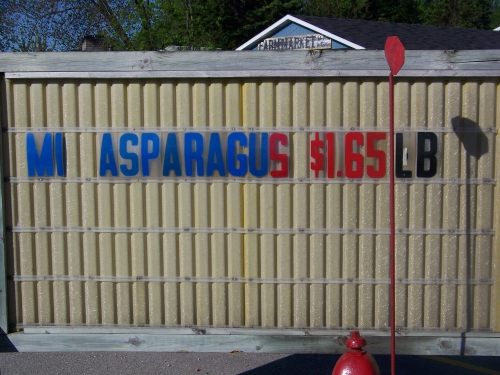The sign at a local market reads $1.65 for Michigan asparagus
Did you know that Michigan is the 3rd largest producer of asparagus in the United States?
 I must confess that my family has not traditionally been big consumers of asparagus. I don’t know why, though, as it is very healthy, nutritious and is grown and readily available in Michigan. It is a vegetable that can be prepared in so many ways- grilled, broiled, sautéed, steamed, baked in casseroles and eaten raw in salads-yet I don’t know much about it.
I must confess that my family has not traditionally been big consumers of asparagus. I don’t know why, though, as it is very healthy, nutritious and is grown and readily available in Michigan. It is a vegetable that can be prepared in so many ways- grilled, broiled, sautéed, steamed, baked in casseroles and eaten raw in salads-yet I don’t know much about it.
According to the Michigan Asparagus Advisory Board, Michigan ranks third in the nation, producing up to 25 million pounds of asparagus annually. In 2010, the leading asparagus-producing county in Michigan was Oceana County, with areas around Hart and Shelby being the biggest producers. However, there is also substantial production in southwest Michigan between South Haven and Benton Harbor. Harvested from late April through mid-late June, the total value of asparagus production in Michigan is estimated to be more than $15 million.
Asparagus is a member of the lily family and grows best on well-drained soils. While the crop prefers sand, it will survive any place where water does not stand and which receives a lot of direct sunlight. It is a cool-season perennial crop and, after planted, is not harvested for the first two years to allow the crowns to develop strong root systems. A well cared for planting will be productive for 10 years or more. Michigan producers harvest approximately 11,000 acres of this ferny vegetable annually. Fields yield between 2,000 and 3,500 pounds per acre. Twenty-five percent of the harvest is sold fresh in the produce department and 75% is sold to processors who freeze or can the cuts and tips or whole spears.
The Michigan Asparagus Advisory Board’s website has many interesting facts, recipes and answers to commonly asked questions about asparagus. For instance, it indicates that asparagus should be picked, for best results, when it is firm, fresh and when it has closed, compact tips that are uniform in size. Consumers should cook trimmed asparagus for five to eight minutes in boiling water for best results. Growers do not cut the ferns down until late fall when they have turned brown as it is the fern that provides nutrients to the crown so that it will produce next year.
According to the US Recommended Daily Allowances (USRDA), five spears (5.3 ounces) provide 400 milligrams of potassium, three grams of fiber, 60 percent of recommended folacin and are excellent sources of thiamin and vitamin B6. They also contain only 20 calories, have no fat or cholesterol and only five milligrams of sodium. Visit www.asparagus.org for more information from the Michigan Advisory Production Board.
How about the 2011 crop? According to the Michigan Agricultural Crop Marketing Association’s Asparagus Division, even with the late start, asparagus deliveries to processors are still ahead of where the state was at this point in the season last year. In addition, Norm Myers, MSU Extension vegetable production educator, indicates that fresh prices and supplies continue to be strong despite the periodic struggle to deliver a quality product during periods of heat and humidity. So, go ahead and pull out your favorite recipes, as there will be plenty of Michigan asparagus for you to purchase, preserve and enjoy!



 Print
Print Email
Email




